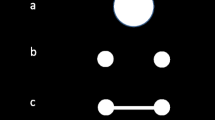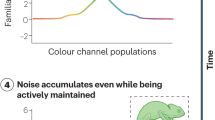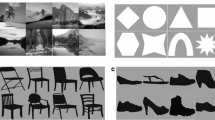Abstract
In two experiments, we used a temporal integration task to investigate visual mental images based on information in short-term memory or generated from information stored in long-term memory (LTM). We specifically asked whether the two sorts of images rely on depictive representations. If mental images rely on depictive representations, then it should be possible to combine mental images and visual percepts into a single representation that preserves the spatial layout of the display. To demonstrate this, participants were asked to generate mental images and then combine them with visual percepts of grids that were partially filled with different numbers of dots. Participants were asked to determine which cell remained empty when the two grids were combined. We contrasted predictions of propositional or verbal description theories with those of depictive theories, and report findings that support the claim that mental images—based on either short-term or LTM—depict information.







Similar content being viewed by others
References
Anderson, R. E., & Helstrup, T. (1993). Visual discovery in mind and on paper. Memory and Cognition, 21, 283–293.
Borst, G., & Kosslyn, S. M. (2008). Visual mental imagery and visual perception: Structural equivalence revealed by scanning processes. Memory and Cognition, 36, 849–862.
Brockmole, J. R., Irwin, D. E., & Wang, R. F. (2003). The locus of spatial attention during the temporal integration of visual memories and percepts. Psychonomic Bulletin & Review, 10, 510–515.
Brockmole, J. R., Wang, R. F., & Irwin, D. E. (2002). Temporal integration between visual images and visual percepts. Journal of Experimental Psychology: Human Perception and Performance, 28, 315–334.
Craver-Lemley, C., Arterberry, M. E., & Reeves, A. (1999). “Illusory” illusory conjunctions: The conjoining of visual and imagined stimuli. Journal of Experimental Psychology: Human Perception and Performance, 25, 1036–1049.
Di Lollo, V. (1980). Temporal integration in visual memory. Journal of Experimental Psychology: General, 109, 75–97.
Eriksen, C. W., & Collins, J. F. (1967). Some temporal characteristics of visual pattern perception. Journal of Experimental Psychology, 74, 476–484.
Finke, R. A., & Slayton, K. (1988). Explorations of creative visual synthesis in mental imagery. Memory and Cognition, 16, 252–257.
Hollingworth, A., Hyun, J., & Zhang, W. (2005). The role of visual short-term memory in empty cell localization. Perception & Psychophysics, 67, 1332–1343.
Jiang, Y. (2004). Time window from visual images to visual short-term memory: Consolidation or integration? Experimental Psychology, 51, 45–51.
Jiang, Y., & Kumar, A. (2004). Visual short-term memory for two sequential arrays: One integrated representation or two separate representations? Psychonomic Bulletin & Review, 11, 495–500.
Jiang, Y., Kumar, A., & Vickery, T. J. (2005). Integrating visual arrays in visual-short term memory. Experimental Psychology, 52, 39–46.
Kosslyn, S. M. (1975). Information representation in visual images. Cognitive Psychology, 7, 341–370.
Kosslyn, S. M. (1980). Image and mind. Cambridge: Harvard University Press.
Kosslyn, S. M. (1994). Image and brain. Cambridge: MIT Press.
Kosslyn, S. M., Ball, T. M., & Reiser, B. J. (1978). Visual images preserve metric spatial information: Evidence from studies of image scanning. Journal of Experimental Psychology: Human Perception and Performance, 4, 47–60.
Kosslyn, S. M., Cave, C. B., Provost, D., & Von Gierke, S. (1988). Sequential processes in image generation. Cognitive Psychology, 20, 319–343.
Kosslyn, S. M., Reiser, M. J., Farah, M. J., & Fliegal, S. L. (1983). Generating visual images: Units and relations. Journal of Experimental Psychology: General, 112, 278–303.
Kosslyn, S. M., & Thompson, W. L. (2003). When is early visual cortex activated during visual mental imagery? Psychological Bulletin, 129, 723–746.
Kosslyn, S. M., Thompson, W. L., & Ganis, G. (2006). The case for mental imagery. New York: Oxford University Press.
Loftus, G. R., & Irwin, D. E. (1998). On the relations among different measures of visible and informational persistence. Cognitive Psychology, 35, 135–199.
Philips, W. A. (1974). On the distinction between sensory storage and short-term visual memory. Perception and Psychophysics, 16, 283–290.
Pylyshyn, Z. (1973). What the mind’s eye tells the mind’s brain: A critique of mental imagery. Psychological Bulletin, 80, 1–24.
Pylyshyn, Z. W. (2002). Mental imagery: In search of a theory. Behavioural and Brain Sciences, 25, 157–238.
Pylyshyn, Z. (2003). Return of the mental image: Are there pictures in the brain? Trends in Cognitive Sciences, 7, 113–118.
Sereno, M. I., Dale, A. M., Reppas, J. B., Kwong, K. K., Belliveau, J. W., Brady, B. R., et al. (1995). Borders of multiple visual areas in humans revealed by functional magnetic resonance imaging. Science, 268, 889–893.
Shepard, R. N., & Metzler, J. (1971). Mental rotation of three-dimensional objects. Science, 171, 701–703.
Thompson, W. L., Kosslyn, S. M., Hoffman, M. S., & Van der Kooij, K. (2008). Inspecting visual mental images: Can people “see” implicit properties as easily in imagery and perception? Memory & Cognition, 36, 1024–1032.
Acknowledgments
This research was supported by Grant R01 MH060734 from the National Institute of Mental Health. Any opinions, findings, conclusions, or recommendations expressed in this material are those of the authors and do not necessarily reflect the views of the National Institute of Mental Health. We wish to thank Ned Block for inspiring this research by bringing the earlier work, and the possible problems with it, to our attention.
Author information
Authors and Affiliations
Corresponding author
Rights and permissions
About this article
Cite this article
Lewis, K.J.S., Borst, G. & Kosslyn, S.M. Integrating visual mental images and visual percepts: new evidence for depictive representations. Psychological Research 75, 259–271 (2011). https://doi.org/10.1007/s00426-010-0304-5
Received:
Accepted:
Published:
Issue Date:
DOI: https://doi.org/10.1007/s00426-010-0304-5




